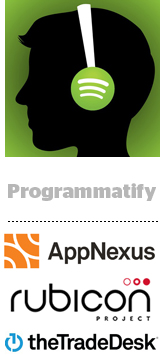 When Spotify partnered with AppNexus, The Trade Desk and Rubicon Project to execute private marketplace (PMP) deals on mobile audio inventory last week, it became the first digital audio company to open its audio inventory to programmatic exchanges.
When Spotify partnered with AppNexus, The Trade Desk and Rubicon Project to execute private marketplace (PMP) deals on mobile audio inventory last week, it became the first digital audio company to open its audio inventory to programmatic exchanges.
To recap: Rubicon Project will be Spotify’s SSP partner, The Trade Desk its DSP partner and AppNexus a partner on both the buy and sell sides.
Spotify previously tested programmatic audio on audio-only exchanges, such as Triton’s a2x. Now, buyers can access Spotify audio inventory alongside display and video.
“Agencies are looking to create a frictionless process in purchasing audio and would like to make their current audio buying more intelligent with data and advanced targeting,” said Les Hollander, global head of audio monetization at Spotify.
And with 70 million of Spotify’s 100 million global listeners using its ad-supported version, supply is significant.
The push toward programmatic audio is companywide. Spotify’s 100-plus direct sales team will execute the buys, supported by a small programmatic team of seven.
“We really want to integrate it across the business and avoid having it siloed,” said Jana Jakovljevic, head of programmatic at Spotify.
For now, Spotify will only sell its mobile audio inventory programmatically and in PMPs, setting different price floors – depending on which Spotify-created segments buyers want to use.
AdExchanger sat down with Jakovljevic and Hollander to discuss how a programmatic Spotify could change the nature of digital audio – and even mobile – buying.
AdExchanger: You’ve been building up to this all year. What was the process like to get here?
JANA JAKOVLJEVIC: We worked with the IAB to establish a digital audio standard for open RTB, released in January. It really outlined the digital audio standard for programmatic.
In January we started approaching AppNexus, Rubicon Project and The Trade Desk. We said, “We really want to do this and would love you to be a part of it,” and we were super fortunate that they shared our vision. It’s not easy to add something completely foreign to your product road map – to allocate resources, especially when that request is coming from one publisher. But they rallied and developed this so quickly.
Were buyers requesting programmatic audio?
JJ: The programmatic buyers weren’t asking us to do this. It was really us approaching them and saying, “We’re going to do this and this is how we’re going to do it,” and they were all excited.
Do you expect buyers to reallocate existing display and video budgets or create new budgets?
LES HOLLANDER: There’s not an overabundance of quality audio inventory in the programmatic marketplace because it’s so new. The ecosystem is growing, but it’s not huge by any standard. Everybody’s boat rises as more quality inventory comes to the programmatic marketplace.
JJ: It goes back to using these DSPs that buyers are accustomed to working with, so they can start to extend their programmatic buys across more media. There is definitely a shortage for premium mobile app inventory, which is our format.
How much are you selling direct vs. programmatically, and how are you prioritizing the two?
LH: Currently the very large percentage is transacted traditionally. Programmatic is growing, but it’s a very small percentage right now.
JJ: Each are tailored to a different buyer. Programmatic audio makes much more sense if the buyer is very sophisticated programmatically, if they are targeting device IDs against mobile and web cookies. There are other buyers who may just want reach nationally. Both are important.
What’s the training process for your sales team?
JJ: We do these trainings in person across the different markets. When I joined last year, there was very little knowledge of programmatic. We had to start from the beginning to define the landscape. We started simply with display PMPs and moved to video and audio.
How are you using your unique first-party data for your inventory? What’s possible around audience segmenting?
JJ: We’re making age, gender, genre and playlist data available. A buyer could target a specific demographic and layer on the playlist or the type of music they’re listening to. They’re also in control of daypart targeting and frequency capping (Spotify is very uncluttered – we only serve one ad per user at a time), and they’re doing all of the optimization and geotargeting from their side, which in the US is down to the ZIP-code level.
A few digital audio companies collaborated on an audio measurement standard. What are your thoughts on that? What are your current measurement capabilities?
LH: We don’t have a full picture, but we think more information around audio measurement is a positive, so certainly we’d love to learn more.
Currently, advertisers are getting audience quality information from comScore and quantity information from Triton. The KPIs to measure audio are still somewhat limited at click through rate for engagement. We’d like to take to market new KPIs, particularly on ad effectiveness and data-driven creative, as well as a standard for the audio industry. The video industry has done a good job of bringing KPIs to the marketplace. We’re looking to do something similar.
Are you planning to open your inventory to more vendors and trading desks?
JJ: Absolutely. We hope that all of the DSPs will build support. We’re definitely not applying restrictions. We are speaking to all buyers.
There hasn’t been a very viable mobile ad solution in programmatic. This has scale. Our users listen for over 2.5 hours per day. [We have] all of the targeting possibilities that Les just mentioned. All of the sudden, audio becomes a very powerful medium for a marketer to deliver their message.














